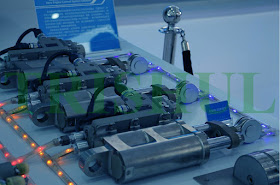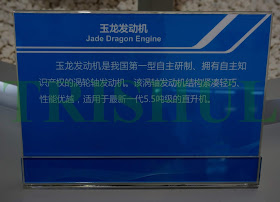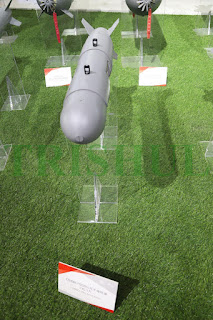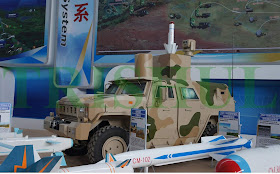Airborne
Multi-Mode Radars
The FM-2000 SHORADS (above) is meant primarily for export and it visually resembles the TOR-M1 SHORADS, which China had acquired in the 1990s from Russia. The replacement for these TOR-M1s is the FM-3000 (below), which was recently service-inducted.
The FM-90 SHORADS (below) is presently in services with the armies of Bangladesh, China and Pakistan.
Air-Defence
Radars
Avionics
Battlefield
Support Missiles
NLOS-BSMs of Chinese origin are
presently being marketed by two state-owned entities: China National Precision
Machinery Import & Export Corp (CPMIEC), and Aerospace Long-March
International Trade Co Ltd (ALIT).
CPMIEC’s 2-tonne B-611MR missile is designed to attack supply lines, warehouses,
ballistic/cruise missile launch sites, SAM batteries, command-and-control
centres, air bases, road/railway transportation hubs, and area targets in urban
surroundings. Armed with a 480kg HE warhead, the B-611M has 280km range. Up to
two cannister-mounted B-611Ms can be carried by a wheeled TEL.
Another NLOS-BSM from CPMIEC is the P-12, which made its public debut in
November 2006. Up to two P-12s are carried in an enclosed compartment mounted
on a 6 x 6 TEL. The P-12 has a range of 150km, and it comes armed with either a
300kg HE blast fragmentation warhead, or a cluster warhead containing 19
anti-armour sub-munitions. Both the B-611M and P-12 have a CEP of about 2
metres when using a RLG-INS coupled to a GPS receiver, plus an optronic sensor
for terminal homing. CPMIEC’s latest NLOS-BSM offering is the
vertically-launched joint attack rocket & missile (JARM) system, which can
fire both the 280km-range BP-12A and
the 200km-range SY-400 from a common
launch platform.
The improved BP-12B BSM has a range of up to 295km. The JARM, which made its public debut in November 2010, makes use of combined GPS-RLG-INS navigation systems to achieve a CEP of 3 metres A typical JARM Battery comprises ten 8 x 8 TELs housing either 80 SY-400s or 20 BP-12As, or a combination of both.
The improved BP-12B BSM has a range of up to 295km. The JARM, which made its public debut in November 2010, makes use of combined GPS-RLG-INS navigation systems to achieve a CEP of 3 metres A typical JARM Battery comprises ten 8 x 8 TELs housing either 80 SY-400s or 20 BP-12As, or a combination of both.
ALIT’s latest product is the M-20. Capable of striking targets
between 70km and 270km, the all-weather capable M-20, with a Mach 3 cruise
speed, comes armed with both a 200kg unitary high-explosive (HE)
blast-fragmentation warhead for engaging high-value and time-sensitive targets,
as well as a sub-kiloton yield tactical nuclear warhead. Two P-20s housed
inside cannisters are mounted on a 8 x 8 transporter/erector/launcher (TEL).
For navigation purposes, use is made of a RLG-INS coupled to a GPS receiver (for
receiving high-accuracy navigational updates in secure PY-code from China’s
‘Beidou’ constellation of GPS satellites), and an infra-red sensor for terminal
homing that gives the missile a CEP of less than 10 metres.
Combat
Aircraft
Helicopters
The design and capabilities of the joint
AHL heavilift helicopter co-development project between China and Russia have
been revised. The helicopter now has increased in maximum takeoff weight to
38.7 tonnes, putting it in the class between the CH-47F Chinook and the Mi-26T.
Similarly, the maximum range of the AHL helicopter has been increased from
630km to 800km, with ramp access for 10 tonnes internal payload, or 15 tonnes
underslung load. The initial agreement to jointly develop this helicopter was
signed by the two countries in 2016.
Space
Technology
Supersonic
Anti-Ship Cruise Missiles
Thrust-Vectoring
Nozzles
The adjustable cover-plates on
the exhaust nozzle—the so-called ‘turkey feathers’—are designed with saw-tooth
edges to reduce the J-10B M-MRCA’s radar cross section (RCS). TVC nozzles
of such a design have proven to significantly reduce both RCS and infra-red
signature. The J-10B equipped with a thrust-vectoring nozzle that is fitted to
the homegrown Woshan WS-10B3 turbofan, whose TTSL has yet to be established.
Turbofans
Beijing has dramatically
stepped up the development of new-generation turbofans and turboshafts since
the turn of the century, with at least US$23.7 billion being invested on R
& D activitiers between 2010 and 2015. The principal R & D players are
the Shenyang Liming Aero-Engine Group
for the Shenyang Aircraft Co; Xi’an
Aero-Engine Group for the Xi’an Aircraft Co; and Chengdu Aero-Engine Group/Guizhou Liyang Aero-Engine
Group for the Chengdu Aircraft Co. In addition, AVIC Commercial Aircraft Engines (ACAE),
a company formed in August 2016 with an investment of around $7.5
billion and through the merger of 24
companies with about 10,000 employees, is spearheading the development of
turbofans for commercial airliners and business jets now being developed by Commercial
Aircraft Corp of China, Ltd (COMAC).
Being developed are the 78kN-thrust CJ-500 turbofan and the 80kN-thrust WS-12C Tianshan turbofan for mid-sized business jets, the 340kN-thrust CJ-2000 turbofan for the Sino-Russian CR-929 widebody airliner, and the 196kN thrust CJ-1000AX Changjiang turbofan for the C-919 narrow-body airliner. This is a twin-spool, unmixed, high-bypass ratio direct-driven turbofan with clockwise co-rotating spool and five bearing-support struts for rotors. It includes a first-stage fan, three-stage booster section, 10-stage high-pressure compressor, single annular combustor section, two-stage high-pressure (HP) turbine and a six-stage low-pressure (LP) turbine.
Being developed are the 78kN-thrust CJ-500 turbofan and the 80kN-thrust WS-12C Tianshan turbofan for mid-sized business jets, the 340kN-thrust CJ-2000 turbofan for the Sino-Russian CR-929 widebody airliner, and the 196kN thrust CJ-1000AX Changjiang turbofan for the C-919 narrow-body airliner. This is a twin-spool, unmixed, high-bypass ratio direct-driven turbofan with clockwise co-rotating spool and five bearing-support struts for rotors. It includes a first-stage fan, three-stage booster section, 10-stage high-pressure compressor, single annular combustor section, two-stage high-pressure (HP) turbine and a six-stage low-pressure (LP) turbine.
The Shenyang-Liping WS-20 high-bypass turbofan
for the Xian Aircraft Industrial Corp Y-20 Kunpeng strategic
airlifter has been developed to produce 14 metric tonnes of thrust, which
will enable the Y-20 to achieve its maximum payload of 66 metric tonnes. Touted
as China’s most powerful turbofan to be developed to date, the WS-20 has been
flight-tested on an IL-76 testbed since 2014. The WS-10A is a low-bypass,
two-shaft turbofan in the 130kN-thrust class. This engine had a TBO of only 30 hours,
while the AL-31F turbofan powering the Su-27 had a 400-hour TBO. The WS-10A
has suffered blade warp and destruction both during ground testing and
also under high-RPM, rapid-turn conditions in flight that produce high
centrifugal and g-forces. China’s third-generation single-crystal turbine
blades can withstand temperatures of up to 2,000 degrees Celsius) and have
found application on the 140kN thrust WS-10B turbofan, which has a TTSL of
1,500 hours. However, China still is far away from mastering the production
technologies for superalloys, thermal barrier coatings, powder metallurgy, and
single-crystal blades using rare-earth metals. The 150kN-thrust WS-15 Emei,
designed for the Chengdu J-20 stealthy MRCA, exploded during a ground running
test in 2015 due to quality-control issues with its single-crystal turbine
blades. Lastly, there is the 49kN-thrust Minshan turbofan that has
been developed for the for Hongdu L-15 lead-in fighter trainer. Turboshaft
engines already developed by China include the 1,300shp WZ-9 for attack
helicopters, 2,400shp WZ-10 for medium-lift helicopters, and the
525shp WZ-161 for light medium twin helicopters.
Unmanned
Aerial Vehicles
Chinese companies like ASN Technology
Group, China Aerospace Science and Industry Corp (CASIC), China Aerospace
Science and Technology Corp (CASC), Zhuhai Yintong Energy, Weifan Freesky
Aviation Industry Co, and AVIC Defense presently account for most of the UAVs
and UCAVs built thus far. ASN Technology Group works closely with the
Xian-based Northwestern Polytechnical University’s UAV Institute, and the
Beijing- and Nanjing-based Universities of Aeronautics and Astronautics (BUAA),
Beijing Technology Company, Hebei Electric Power Reconnaissance Design Academy,
Northwestern Polytechnical University, Shaanxi Engine Design Institute, Guizhou
Aviation Industry Corp (GAIC), and the Chengdu
Aircraft Design and Research Institute.
The CH-5 (above) is
powered by a 456kW WJ-9A turboprop engine, while the CH-4 is equipped
with
a Rotax 014 piston engine imported from Austria’s BRP-Powertrain. More than 60% of all components for the Wing Loong
family of UAS platforms come from private-sector companies of China. The CH-5 has a maximum takeoff weight of 4,200kg, nearly four
times greater than the CH-4. Of its six hardpoints, four of them can carry
double payloads, giving the UAS a potential payload of ten air-to-surface
precision-guided munitions. Maximum
takeoff weight is 4,200kg, maximum external load-carrying capacity is
480kg, maximum cruise speed is 370kph, service ceiling is 9km, and
endurance is 20 hours. While the CH-4 is in service with China’s armed forces,
the CH-5 has to date been ordered only by Saudi Arabia and Pakistan. On March 16 last year, Saudi Arabia’s the King
Abdulaziz City for Science and Technology signed an industrial partnership
agreement with the state-owned China Aerospace Science & Technology Corp
(CASC) to establish a manufacturing plant in Saudi Arabia for as many as 300
CH-4 and CH-5 UAS platforms.
The
CaiHong (Rainbow)-7 (above), developed by the 11th Research Institute of China
Aerospace Science & Technology Corp (CASC) is a high-altitude,
long-endurance, stealthy platform with claimed significant penetration
capabilities. The flying wing measures 72 feet (22 metres) wide and has a
maximum takeoff weight (MTOW) of 13 tonnes, payload of 2 tonnes, and top speed
of Mach 0.75. While the aircraft remains in the developmental stage, a
corporate video shows that first flight is planned for 2019 and it will enter
production by 2022. If successful, it will validate the capabilities of China
to develop a fly-by-wire flight-control system for a large, tailless flying
wing and could even pave the way for the country’s next-generation H-20 strategic
bomber project.
The China Academy of Aerospace
and Aerodynamics (CAAA) has developed the CH-10 tilt-rotor UAV (above) that is a new-design
vehicle integrating helicopter and fixed-wing aircraft technology. The main
mission of the CH-10 is to accompany large- and medium-sized warships or ground
forces and to conduct intelligence, reconnaissance, detection, communications
relay, search, target identification, and relay guidance to ground stations. The
shift of flight modes is done through the tilting rotor. It can take off and
land on destroyers and frigates.
The Cloud Shadow (below) is a family of
swept-wing platforms. Though AVIC says this UAS first flew on May 16, 2016, it
has not specified which variant. There are three variants now being promoted:
imagery reconnaissance (designated CS-1), electronic reconnaissance (CS-2), and
reconnaissance-strike (CS-3). Each of them is powered by a WP-11C turbojet
mounted between the butterfly tails, providing a claimed maximum speed of 281
Knots and cruise speed of 227 Knots. Endurance is five hours and cruising
altitude is 41,000 feet. Maximum takeoff weight is 3,200kg, while the wingspan
is 66 feet. The first two variants have an internal 200kg payload capacity,
while the CS-3 has an external payload of 400kg, spread across four pylons (two
of which are of the twin-rack type). According to AVIC, a full load-out
consists of a single FT-7A 100kg range-extended, precision-guided glide-bomb,
and a pair of LS-6/50s, the 50kg version of the LS-6 laser-/TV-guided bomb. The
CS-2 features a pair of ELINT/COMINT sensors in a fairing below the nose. AVIC
claims a frequency range of 0.8-18GHz at up to 400km for the former and
0.1-2GHz at up to 200km for the latter. The CS-1 carries SAR and long range
oblique photographic (LOROP) sensors. An operational concept image in the
presentation shows the CS-1 flying 18km inside hostile airspace, and with
effective standoff ranges for the LOROP of 68km, and 70km for the SAR. The GCS
can be provided in fixed, vehicle-mounted or portable configurations, and
features six user-defined touch-screen displays, a QWERTY keyboard with
separate numerical keypad, and two joysticks. This can be used to control both
the CH-4/CH-5 and Cloud Shadow UAS platforms. AVIC also provides data-links,
including a C/UHF-band line-of-sight link, Ku-, Ka- and S-band satellite links,
an L-band miniature link for the A-Hawks, and all associated ground
terminals.
The JY-300 early-warning UAV (below)
from the China Electronics Technology Group Corp’s (CETC) 38th Research
Institute was first unveiled last June. It features miniaturised active phased-array
radar strips installed on the two sides of the fuselage and the leading-edge of
the wings. Unlike most conventional UAVs with a radar payload, the integrated
and conformal design of the JY-300 reduces drag and thus retains most of the
UAV’s inherent flight performances. CETC claims that the radar suite has a range
of around 620 miles (1,000km) and can provide surveillance of hostile warships,
helicopters, and missiles from a standoff range. Additionally, the UAV
presents a smaller radar cross-section, and the unmanned and cheaper nature of
the platform allows the user to free up heavier manned AEW &CS platforms
for more critical airborne battle management operations.
China Aerospace Science &
Industry Corp’s (CASIC) turbofan-powered WJ-700 high-altitude, high-speed UCAV (below) strongly
resembles the MQ-9 Reaper and CH-5 UCAV, with a turbofan replacing the
rear-mounted propeller. The WJ-700 has an MTOW of 3.5 tonnes, and endurance of
20 hours. CASIC describes the WJ-700 as designed for long-range anti-ship
missions, anti-radiation missions, as well as electronic warfare and jamming.
The concept model suggests four underwing pylons for a variety of munitions,
including the CM-502KG anti-ship cruise missile and the CM-102 anti-radiation
missile.
Two unmanned
helicopters made test-flights in 2017 on the Qinghai-Tibet Plateau. While the
AV-500W conducted firing tests at an altitude of 4,300 metres in Qinghai
province on November 18, 2017 (according to Jiangxi provincial office of
science, technology and industry for national defence), at 4,600 metres above
sea level, on November 9, 2017 an XM-20 multi-rotor unmanned drone took off and
landed with a full payload. The AV-500W had
earlier climbed to an altitude of 5,006 metres during tests on October 31, the
maximum achieved by a domestically-made unmanned helicopter. These VTOL-UAVs have applications in
counter-terrorism, drug policing, border patrols, meteorology and mapping.
The aircraft were developed by a helicopter
research and development institute in Jingdezhen, Jiangxi province, owned by
AVIC. The institute began work on
unmanned helicopters in 2004.
AVIC had revealed two updated designs of
its AV-500W VTOL-UCAV at the fourth China Helicopter Exposition held in
Tianjing in mid-September 2017.
The AV-500W was unveiled at the 2016 Zhuhai Airshow. Its designers from the
China Helicopter Research & Development Institute have now given the
AV-500W a smaller and sleeker appearance. The design concept is similar to that
of the Northrop Grumman MQ-8B Firescout, but one-third the weight of its
Western counterpart. The airframe measures 7.2 metres/23.6 feet long, 2.3
metres/7.5 feet high and 1.6 metres/5.2 feet wide, and its maximum takeoff
weight has been reduced from 470kg/1,036 lb to 450kg/992 lb based on the
latest specifications. The VTOL-UCAV has a maximum speed of 170kph, and a
combat radius of 200km. The primary armaments include the new FT-8D anti-armour
guided-missile carried on four underwing hardpoints. The FT-8D is a semi-active
laser-guided missile with a range of up to 5km. According to AVIC, this
missile was tested in the early half of 2017 and yielded satisfactory results.
The AV-500W can also carry conventional bombs, as well as external loads
relevant to search-and-rescue operations. Countries in Africa, Latin America
and the Middle East, such as Saudi Arabia and United Arab Emirates, have shown
interest in this VTOL-UCAV, especially for counter-insurgency missions. The AV-500W is the armed variant of
the AV-500 civilian UAV, which is 2.415 metres high, 7.204 metres
long and can take off at up to 470kg maximum weight, with mission payloads not
exceeding 160kg, including 120kg of equipment, including an optronic ball, a
SAR radar and other communications devices. The UAV has an 8-hour autonomy in flight and is capable of reaching
4,000 metres of altitude at a maximum speed of 170kph.
UAVs For Tactical Transportation & Airspace Surveillance
Mini-UCAVs For Urban Counter-Terror Operations
Combat-Support Platforms
Stealthy UCAV Concept
Aerobatic Displays
Theatre Command JOCIS
(Many More To Come)
MoD's Response To Rafale Petition




































































































































































































































































